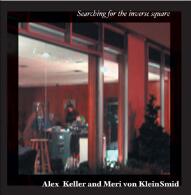Alex Keller and Meri von KleinSmid, Searching for the inverse square
review by dave heaton
 "Searching" is definitely the right word for Alex Keller and Meri von KleinSmid's CD Searching for the inverse square. During all four of the collaborative, improvisatory performances collected on the CD, there's a distinct sense that they're are searching for something, that they're trolling through our collective memories and pop-culture consciousness in search of some truth that must lie within. That truth, of course, is elusive and more than likely non-existent. But the search itself is captivating, thought-provoking and sensuous.
Each of the four performances took place in a different setting, and each used different devices as instruments. But the methodology was the same - using various sound-generating devices and moving them around, so that the recording captures a flurry of appearing and disappearing sounds. Two of the performances utilize machines that will echo through listeners of a certain age as remembrances of their childhood - "Phar Lap" uses a Speak n' Math machine and "Focused on the conflict at hand" uses two Atari systems and an Atari-themed record. In both cases these sounds are both comforting and unusual, familiar and foreign. Both offer melodic elements that make those tracks almost have an IDM accessibility to them, yet at the same time it seems silly to suggest that, as overall the feeling is disjointed and strange. The video-game explosions sounds in "Focused on the conflict at hand" echo within me in various conflicting ways, as I'm hyper-aware of the sounds' original sources (and therefore risk slipping into childhood memories and not coming back), yet trying to listen in an abstract way evokes scenes of war, or at least media representations of war (action films, cartoons).
"Searching" is definitely the right word for Alex Keller and Meri von KleinSmid's CD Searching for the inverse square. During all four of the collaborative, improvisatory performances collected on the CD, there's a distinct sense that they're are searching for something, that they're trolling through our collective memories and pop-culture consciousness in search of some truth that must lie within. That truth, of course, is elusive and more than likely non-existent. But the search itself is captivating, thought-provoking and sensuous.
Each of the four performances took place in a different setting, and each used different devices as instruments. But the methodology was the same - using various sound-generating devices and moving them around, so that the recording captures a flurry of appearing and disappearing sounds. Two of the performances utilize machines that will echo through listeners of a certain age as remembrances of their childhood - "Phar Lap" uses a Speak n' Math machine and "Focused on the conflict at hand" uses two Atari systems and an Atari-themed record. In both cases these sounds are both comforting and unusual, familiar and foreign. Both offer melodic elements that make those tracks almost have an IDM accessibility to them, yet at the same time it seems silly to suggest that, as overall the feeling is disjointed and strange. The video-game explosions sounds in "Focused on the conflict at hand" echo within me in various conflicting ways, as I'm hyper-aware of the sounds' original sources (and therefore risk slipping into childhood memories and not coming back), yet trying to listen in an abstract way evokes scenes of war, or at least media representations of war (action films, cartoons).
"The best station is no station" has a title which gets at the de-centering feeling of these works with a tone that seems possibly hopeful and freeing, yet the piece itself is somehow the most disturbing of the four. Battery-operated radios pick up fragments of music, commercials, and news reports ('news' meaning traffic and weather as much as anything) in a way that's suggestive of how overwhelmed we are with media sources these days; in this context the voices of a family playing a hide-and-seek game that are entwined throughout the piece come across alternately like screams and glimpses of a more people-based world.
"Message from Bunker 23" uses cassettes filled with found-sound (for example, a fragments of a radio commercial, rewinded and fast-forwarded, begins the piece) but also the natural sounds of the environment in which it was recorded, the entrance to a un-used bunker, inside a park that was formerly part of a nearby Navy base. Bird, airplanes, and the cassette sounds - manipulated radio voices and music - commingle in way that always feels uneasy yet sometimes feels natural to me. Is that just me adopting to our times? Used to the co-existence of the natural world and our sometimes monstrous society? I don't know...but there's something peaceful about the piece to me, even as it's an eerie sort of peace.
Taken as a whole, the four improvisations on Searching for the inverse square are filled not just with sounds but ideas. Yet the ideas are more stirred to the surface from within our own brains than communicated to us. Alex Keller and Meri von KleinSmid's probing techniques stir up thoughts, feelings and impressions that are likely to be different for each individual, though many general themes will no doubt be explored by each person listening. Those are themes that are no doubt already on the brain of most people today, by the way: 24-hour news channels, war, fears, memories. Searching for the inverse square's chief success is the way it pokes into the modern consciousness in a way that's likely to provoke listeners, not just into reacting to art, but into thinking about the current state of things.
Copyright (c) 2005 erasing clouds |
|